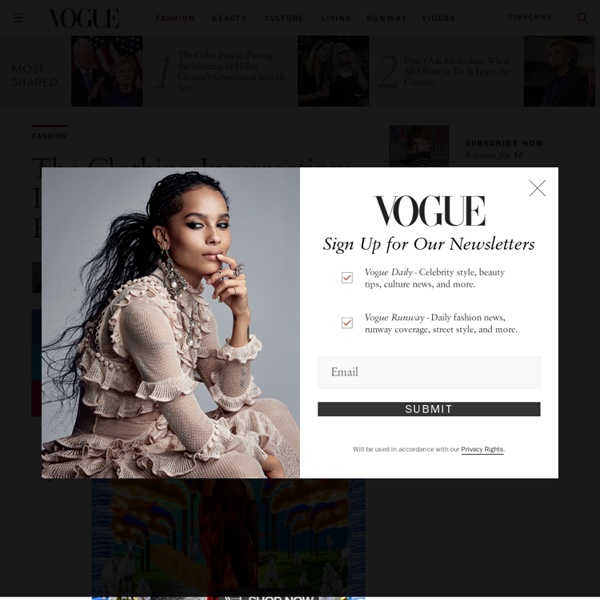The Global Economics of Fashion and Clothing - Part 1 – Clothing | Elliott Morss
How Important Personal appearance – how we look – is important to most people. Nevertheless, we spend very little on clothing. Table 1 provides consumption expenditure shares for selected developed nations. On average, these countries spend only 4% on clothing. Table 1. – Consumption Expenditure Shares, Selected Countries, 2008 Source: OECD (2010),”Final consumption expenditure of households”, Detailed National Accounts (database). Table 2 provides data on total and per capita clothing expenditures in selected developed nations. Table 2. – Clothing Expenditures, Selected Nations, 2008 International Trade As Table 3 indicates, the United States is by far the largest importer of clothing. As the last column in Table 3 indicates, most clothing is produced domestically. Table 3. – Clothing Imports, Selected Nations (mil. Source: Table 4 provides data on the leading clothing exporters. Table 4. – Largest Clothing Exporters (mil. Recession Effects Fashion
Brexit causes dramatic drop in UK economy, data suggests
Image copyright Getty Images Britain's decision to leave the EU has led to a "dramatic deterioration" in economic activity, not seen since the aftermath of the financial crisis. Data from IHS Markit's Purchasing Manager's Index, or PMI, shows a fall to 47.7 in July, the lowest level since April in 2009. A reading below 50 indicates contraction. Both manufacturing and service sectors saw a decline in output and orders. However, exports picked up, driven by the weakening of the pound. The report surveyed more than 650 services companies, from sectors including transport, business services, computing and restaurants. It asked them: "Is the level of business activity at your company higher, the same or lower than one month ago?" It also asked manufacturers whether production had gone up or down. The PMI is the first significant set of data measuring business reaction to the result of the UK referendum. Business Live: Pound tumbles Chancellor may 'reset' economic policy 'Record slump' 'No surprise'
Cartier’s $600,000 Watch Shows Risks of Extending Luxury Brands | News & Analysis | BoF
GENEVA, Switzerland – For over a century, Cartier has sold elegant, if simple, timepieces such as the Tank, which starts around $2,500 – affordable by Swiss watch standards, and never confused with the level of technical finesse from brands like Patek Philippe. Then a decade ago, Cartier sought to prove its own prowess, investing millions to build one of Switzerland’s largest watch factories and bringing in an industry veteran to head a fine watchmaking unit. The jeweller delved into the segment for connoisseurs known as “complicated pieces,” which sport analog mechanisms such as calendars that adjust for leap years and require painstaking hand craftsmanship. The effort culminated last year in the Rotonde de Cartier Grande Complication Skeleton, a glass-backed confection priced at more than $600,000. But then the Chinese demand that had supported the market collapsed. For Cartier, a brand traditionally associated with jewellery for women, joining that men’s club was a stretch.
Top 5 Global Cities To Live And Do Business In 2016
Article provided by Bayut.com When it comes to living in a foreign city, one has to consider the population, infrastructure, overall size, political context, per capita income and development path. The city’s economic growth, real estate developments and entertainment facilities also play a vital role in making decisions towards moving to a city or investing in it. Here we compile a list of five cities to look out for while aiming at living or investing internationally in 2016. Each of the cities listed below features trophy developments along with impressive mixed-use communities and have good room for growth, which is achievable through improvements in transparency, livability and business environment. 5. Being the world’s sixth most globalized city, Shanghai could become your best bet for investment in East Asia. 4. Dubai, the Middle East’s most modern city, has a population of around 2.1 million and a total area of 4,114 km². 3. 2. 1. 34shares
Economy Of Fashion: How Different Trends Reflect The Financial State
It's common knowledge fashion is cyclical in nature. The concept of “newness” in fashion doesn't refer to the premiere of a trend, but rather its revival. Why fashion cycles in this manner, however, is less obvious. There are lots of factors at play: cultural trends, politics, celebrity influence. One one of the most surprising factors to influence the cycle of fashion, though, is the state of the global economy. If you think about it, it makes sense. During tougher times, if you need new clothes, the focus is less on passing fads and more on classic, quality pieces worth the expenditure because they’ll last (which also aids in cutting down cost per wear). As FIT professor John Mincarelli tells ABC News, “In rough economic times, people shop for replacement clothes,” adding “basics” prevail during an economic downturn. Economist George Taylor was the first to notice the correlation between fashion and the economy; he developed the “Hemline Theory” to describe his findings. Pinterest How?
Global fashion industry statistics - International apparel
Total trade of clothing and textiles: 726 billion dollars The most traded apparel and textile products are non-knit women’s suits, knit sweaters, knit T-shirts and non-knit men’s suits. Non-knit women’s suits: 54.6 billion dollars, 7.5 percent Knit sweaters: 52.8 billion dollars, 7.3 percent Non-knit men’s suits: 43.4 billion dollars, 6 percent Knit T-shirts: 36.9 billion dollars, 5.1 percent Knit Women’s suits: Knit women’s suits: 28.2 billion dollars, 3.9 percent Light rubberized knitted fabric: 23.9 billion dollars, 3.3 percent Synthetic filament yarn woven fabric: 20.9 billion dollars, 2.9 percent Raw cotton: 18.9 billion dollars, 2.6 percent Non-retail synthetic yarn: 18.8 billion dollars, 2.6 percent China is the largest exporter of apparel in the world, it has exported for 265 billion dollars in 2014. India is the second largest exporter with 38.7 billion dollars of clothing exports. Total trade of footwear and headwear: 139 billion dollar



